
Swimming pools tend to be our go-to beat-the-heat destination, but have you ever thought of spending the season with Mother Nature? The U.S. is blessed with a plethora of bucket list-worthy natural wonders, from the best natural parks to scenic boating destinations and natural swimming holes.
There’s no need to trek to Thailand or some undiscovered South American waterfall, as America’s swimming holes boast crystal-blue waters, majestic waterfalls, and jaw-dropping landscapes. What are you waiting for? Pack your sunscreen and swim trunks; we’re going on a grand road trip to the best natural swimming holes to check out in 2024.

Havasu Falls, Arizona
Nothing about the Grand Canyon disappoints, and Havasu Falls is no exception. Situated on the 188,000-acre tribal reserve of the Havasupai people — long considered the guardians of the Grand Canyon — the falls provide a unique destination for hikers that’s unlike any other in the U.S. The stunning falls are difficult to get to, requiring a 10-mile hike each way, so the journey isn’t for the feeble. They can be reached on foot or on horseback, and it may be best to go with a guide like Wildland Trekking to handle the logistics. The company even offers a helicopter option to cut the hiking down to just 2 miles.

Hamilton Pool, Texas
As if you needed another reason to visit Austin, Texas, one of the most stunning pools in the Lower 48 is located 23 miles west of the city. Hamilton Pool Preserve is the result of a limestone dome collapse over an underground river some thousands of years ago (travelers familiar with Mexican cenotes will recognize the geological anomaly immediately). It’s one of the easiest pools to reach on this list, and while that guarantees you’ll have plenty of company there, it’s still well worth the drive.
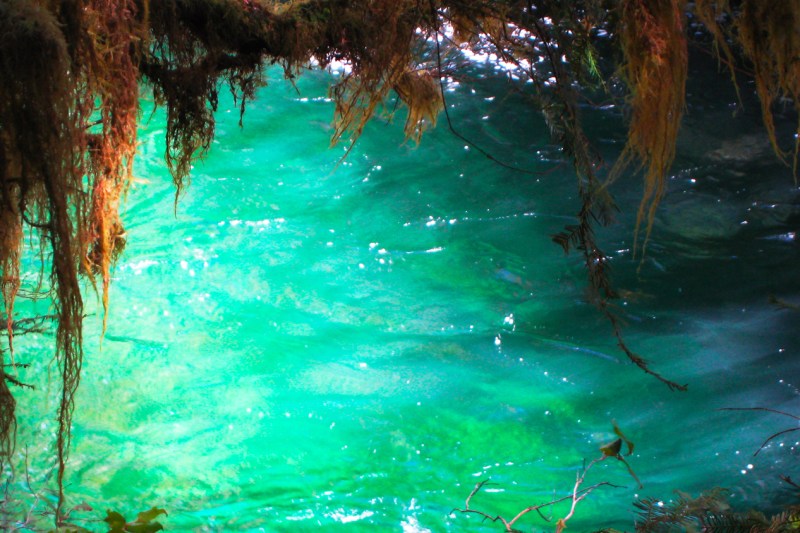
Opal Pool, Oregon
Given the modest start of this trail along an ordinary gravel road just outside the mining town of Jawbone Flats (interesting in its own right), it’s easy to imagine there’s no real payoff at the end. But a hiking trail soon reveals itself with a bridge that leads across Opal Creek. Follow the path a bit farther, and you’ll reach Opal Pool, an impossibly beautiful emerald green lagoon bookended by dramatic rock walls and lush old-growth trees.
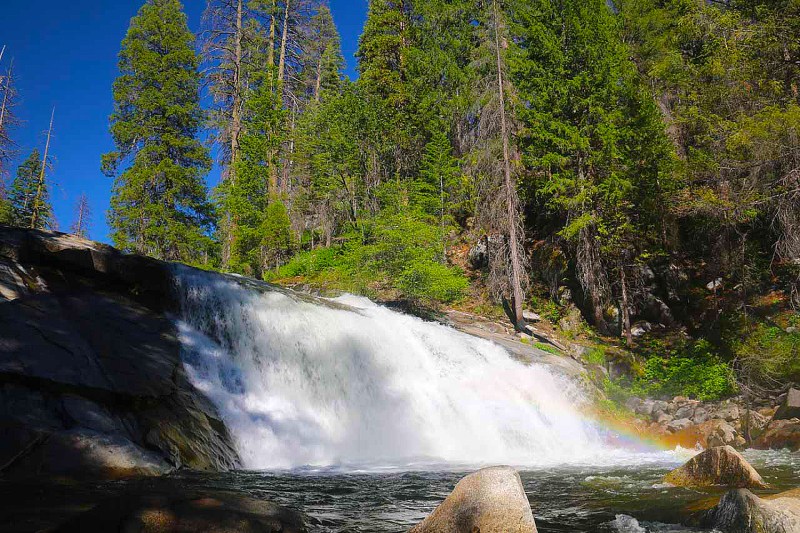
Carlon Falls, California
For visitors to Yosemite Park’s Hetch Hetchy, Carlon Falls is an easy diversion just off Evergreen Road. The aptly named Carlon Falls Trail leading to the falls is a mostly level 2-mile amble, much of which is rarely seen by park visitors. The 35-foot falls run year-round, and on most days, you’ll likely have them all to yourself. The idyllic, boulder-laden swimming hole near the falls is surrounded by ponderosa pine trees and brilliant fields of sunflowers.

Little River Canyon, Alabama
The fittingly named Little River Canyon National Preserve provides 12 miles of idyllic swimming holes for visitors to Alabama’s Lookout Mountain area. The 600-foot-deep canyon offers one of the most dramatic drops east of the Mississippi River. A short drive downriver from the state’s Highway 35 bridge, you’ll find the most easily accessible lagoon at the base of Little River Falls. Go when water levels are low, as high water can prove dangerous. For something a little more adventurous, hike 0.75 miles from Eberhart Point to the floor of the canyon, where several cliffs provide ideal launch pads for cliff diving.

Cummins Falls, Tennessee
Locals have known about the 282-acre Cummins Falls State Park for more than 100 years. However, thanks to the internet, the “secret” of the park’s namesake falls is out. Hikes to the falls are relatively short — between 1 and 1.5 miles, depending on which route you take — but steep, with significant elevation changes along the way. The payoff for more adventurous travelers, however, is a 75-foot waterfall that’s the eighth-largest in the state by volume. At its base lies a spectacular, Instagram-worthy swimming hole.
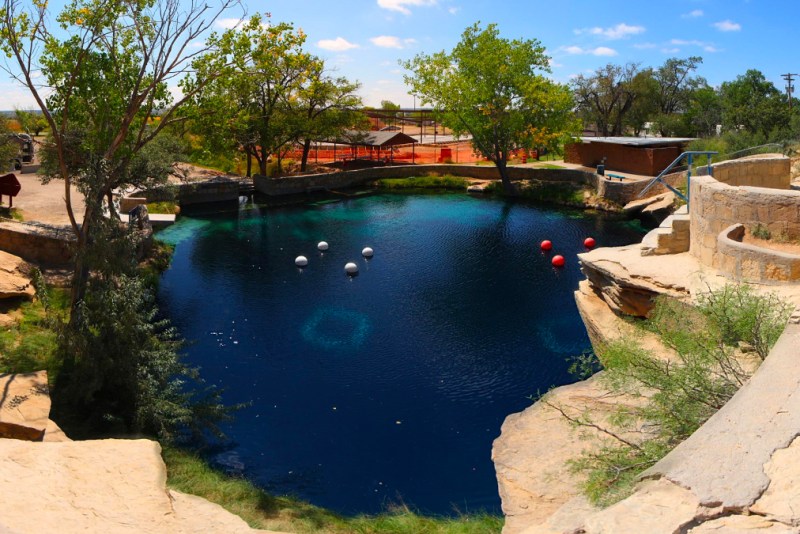
Blue Hole, New Mexico
The Santa Rosa Blue Hole is no secret — it’s been a popular spot for decades. However, the natural New Mexico aquifer is most fascinating because of its location in one of the driest states in the U.S. Its unique bell shape means it’s only 80 feet wide at the surface, but it expands to 130 feet wide at the bottom. The one-time fishing hatchery has evolved over the years as a public-use swimming hole. Due to its clear water and constant 61-degree Fahrenheit temperature, it’s also among the most popular spots in the country for scuba diving and dive training.
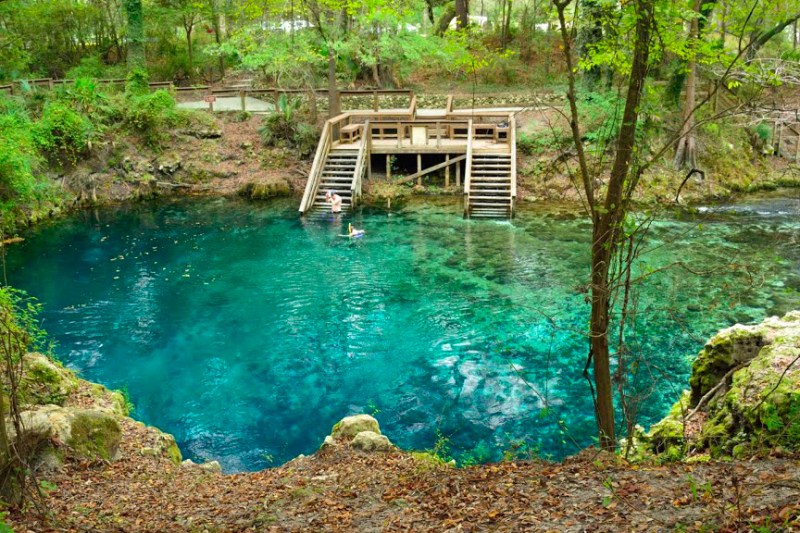
Madison Blue Spring, Florida
One of Florida’s best natural swimming holes is surprisingly situated in one of the state’s newest parks. Located not far from the Georgia line, on the west bank of the Withlacoochee River, is Madison Blue Spring State Park. The 150-foot by 82-foot lagoon boasts 25 feet of gin-clear water that’s ideal for casual swimming or full-on cave diving. The only downside: Plan to go early. All this beauty means you’ll have plenty of company during your visit.

Hali’i Falls, Hawaii
Hawaii is home to many of the most stunning natural wonders in the country, so it’s no surprise the island chain boasts some of its most incredible swimming holes as well. Hali’i Falls (which translates to “spread out,” an apt description of the layout of the falls) is a spectacular cascading series of falls on the island of Kauai. They’re tucked into a remote part of the island that’s only accessible via a long hike through washed-out marshes and dense bamboo forests. It’s a trek even for adventurous travelers, but the payoff is like something out of Lord of the Rings.

Lost Lake, Alaska
Alaska is a place of superlatives: The biggest, the deepest, the highest, the list goes on. So, it’s hard to pick a “best” anything. However, Lost Lake near Seward has it all. Getting there requires a 7-mile hike one way along the aptly named Lost Lake Trail. It’s a relatively moderate hike, but the payoff is well worth the trek. The lake is surrounded by tarns, chasms, and a nearby creek, plus, there’s a glacier to the west and two more to the east, all of which make it a fantastic spot to camp as well. It’s popular among locals, but it’s not hard to find a beautiful piece of grass all to yourself, even in the scorching months. Just be prepared: The water is damn cold any time of year.
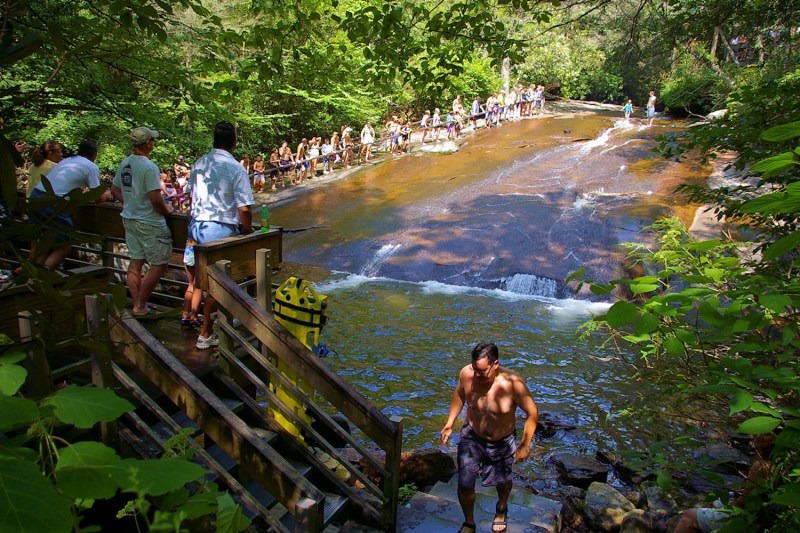
Sliding Rock, North Carolina
Sliding Rock is unique among this list because it’s more like a ride than a wading pool. Located near the pint-sized city of Brevard in Western North Carolina, the 60-foot-long rock forms a natural, gently sloping water slide that drops into a 7-foot-deep plunge pool at the end. Sliders are propelled down the rock wall by more than 11,000 gallons of water flowing every minute. It’s popular enough that visitors line up for the ride during the scorching months. The best time to avoid the crowds is during the fall, assuming you can brave the “refreshing” 50-degree water temperatures.
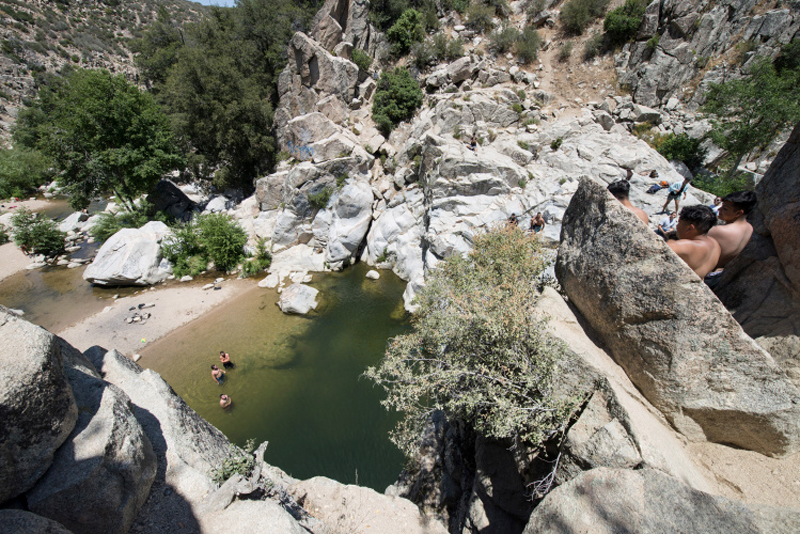
Aztec Falls, California
Deep Creek Canyon in California’s San Bernardino National Forest is littered with incredible natural swimming holes, each seemingly better than the last. However, Aztec Falls is near perfect. Located just a mile off the Pacific Crest Trail, it’s easily accessible, but the payoff is huge. Massive boulders line the bottom of the pool and allow for leisurely wading or more adventurous underwater exploring. The rim is peppered with smooth, flat rocks, all ideal spots for a day of sunbathing. The falls are most popular, however, for their numerous cliff-diving opportunities. Ledges surrounding the pool serve as natural platforms for divers to leap from as low as 20 feet or as high as 60 feet.
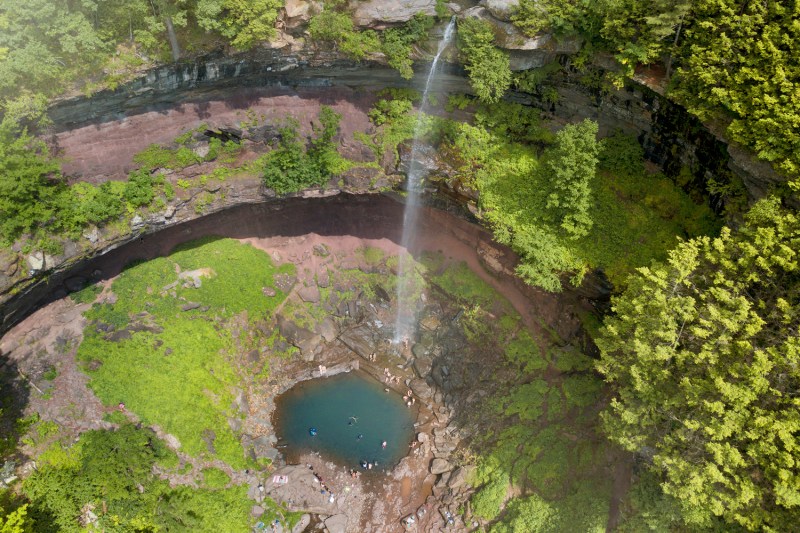
Kaaterskill Falls, New York
Situated more than 100 miles north of Manhattan, Kaaterskill Falls is the most iconic waterfall in the Catskill Mountains. From the parking area, it’s easily reachable via a moderate 1.7-mile out-and-back trail. The two-tiered falls top out at more than 230 feet — higher than Niagara Falls — with the single longest drop reaching 180 feet. It’s worth the hike if only to see the falls. But, thanks to a heavy dose of Instagram fame, many visitors come for the cliff jumping, which is among the best in the Eastern U.S. Those seeking a more leisurely experience can opt to wade in the beautiful pool at the base of the falls.
Are swimming holes safe?
The answer is maybe, as some swimming holes aren’t inherently safe. There are some potential hazards to be aware of before you take a dip, such as natural hazards like slippery rocks, uneven bottoms, hidden currents, and underwater obstacles. Be sure to enter the water slowly and carefully, and avoid jumping in from heights.
The water quality could not be what most people might expect. Swimming holes could be contaminated with bacteria, algae, and other pollutants. Be cautious if the water is cloudy, scummy, or has a bad odor. You can check with the local health department to see if there have been any recent water quality advisories for the swimming hole you’re planning to visit.


